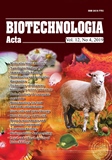ISSN 2410-7751 (Print)
ISSN 2410-776X (Online)

"Biotechnologia Acta" V. 12, No 4, 2019
Р. 50-56, Bibliography 20, English
Universal Decimal Classification: 628.3
https://doi.org/10.15407/biotech12.04.050
Sablii L., Korenchuk M., Kozar M.
The National Technical University of Ukraine "Igor Sikorsky Kyiv Polytechnic Institute", Kyiv
The aim of the research was to determine the degree of influence of nitrate wastewater concentration on the process of removal of phosphorus compounds by sequential water treatment in anoxic and aerobic conditions in an activated sludge system. Model wastewater solutions were used for research with following parameter: biochemical oxygen demand for 20 days –200 mgО2/l; phosphate concentrations – 11.87–12.38 mg/l; nitrate concentrations – 21.0; 36.0 and 48.0 mg/l. Аctivated sludge was added to them with content in solutions 2.2 mgО2/l to provide biological processes. For simulation of the biological process of dephosphotation in wastewater with usage of activated sludge in sequentially formed anoxic and aerobic conditions, a model sequential reactor — SBR reactor — was used. As the results show, with the increase in the concentration of nitrates at the inlet from 21.0 to 48.0 mg/l, the phosphate concentration in the treated solutions at the outlet from the bioreactor increases by 7.3%. Thus, from the work presented here, it can be concluded that for successful and effective implementation of the dephosphotation process the elimination of the nitrate present in wastewater is required. It is reasonable to separate processes of denitrification and dephosphotation in separate structures with the provision of minimal nitrate influence on the phosphorus removal from wastewater.
Key words: phosphate, nitrate activated sludge, wastewater.
© Palladin Institute of Biochemistry of National Academy of Sciences of Ukraine, 2019
References
1. Malovanyy A., Plaza E., Trela J., Malovanyy M. Combination of ion exchange and partial nitritation/Anammox process for ammonium removal from mainstream municipal wastewater. Water Sci. Technol. 2014, 70 (1), 144–151. https://doi.org/10.2166/wst.2014.208
2. Tulaydan Y., Malovanyy M., Kochubei V., Sakalova H. Treatment of high-strength wastewater from ammonium and phosphate ions with the obtaining of struvite. Sci.-Techn. J. Chem. Chem. Technol. 2017, 11 (4), P. 463–468. https://doi.org/10.23939/chcht11.04.463
3. Akpor O. B., Muchie M. Bioremediation of polluted wastewater influent: Phosphorus and nitrogen removal. Sci. Res. Essays. 2010, 5 (21), 3222–3230.
4. Wei D., Shi L., Yan T., Zhang G., Wang Y., Du B. Aerobic granules formation and simultaneous nitrogen and phosphorus removal treating high strength ammonia wastewater in sequencing batch reactor. Biores. Technol. 2014, V. 171, P. 211–216. https://doi.org/10.1016/j.biortech.2014.08.001
5. Kim Y. M., Cho H. U., Lee D. S., Park D., Park J. M. Influence of operational parameters on nitrogen removal efficiency and microbial communities in a full-scale activated sludge process. Water Res. 2011, 45 (17), 5785–5795. https://doi.org/10.1016/j.watres.2011.08.063
6. Zhukova V., Sabliy L., Lagod G. Biotechnology of the food industry wastewater treatment from nitrogen compounds. J. Chem. Chem. Technol. 2011, P. 133–138.
7. Dytczak M. A., Londry K. L., Oleszkiewicz J. A. Activated sludge operational regime has significant impact on the type of nitrifying community and its nitrification rates. Water Res. 2008, 42 (8–9), 2320–2328. https://doi.org/10.1016/j.watres.2007.12.018
8. Othman I., Anuar A. N., Ujang Z., Rosman N. H., Harun H., Chelliapan S. Livestock wastewater treatment using aerobic granular sludge. Biores. Technol. 2013, V. 133, P. 630–634. https://doi.org/10.1016/j.biortech.2013.01.149
9. Wang Y., Peng Y., Stephenson T. Effect of influent nutrient ratios and hydraulic retention time (HRT) on simultaneous phosphorus and nitrogen removal in a two-sludge sequencing batch reactor process. Biores. Technol. 2009, 100 (14), 3506–3512. https://doi.org/10.1016/j.biortech.2009.02.026
10. Yang S., Yang F., Fu Z., Wang T., Lei R. Simultaneous nitrogen and phosphorus removal by a novel sequencing batch moving bed membrane bioreactor for wastewater treatment. J. Hazard. Mater. 2010, 175 (1–3), 551–557. https://doi.org/10.1016/j.jhazmat.2009.10.040
11. Lemaire R., Yuan Z., Bernet N., Marcos M., Yilmaz G., Keller J. A sequencing batch reactor system for high-level biological nitrogen and phosphorus removal from abattoir wastewater. Biodegradation. 2009, 20 (3), 339–350. https://doi.org/10.1007/s10532-008-9225-z
12. Nielsen P. H., Saunders A. M., Hansen A. A., Larsen P., Nielsen J. L. Microbial communities involved in enhanced biological phosphorus removal from wastewater – a model system in environmental biotechnology. Cur. Opin. Biotechnol. 2012, 23 (3), 452–459. https://doi.org/10.1016/j.copbio.2011.11.027
13. Yuan Z., Pratt S., Batstone D. J. Phosphorus recovery from wastewater through microbial processes. Cur. Opin. Biotechnol. 2012, 23 (6), 878–883. https://doi.org/10.1016/j.copbio.2012.08.001
14. Brown P., Ong S. K., Lee Y.-W. Influence of anoxic and anaerobic hydraulic retention time on biological nitrogen and phosphorus removal in a membrane bioreactor. Desalination. 2011, 270 (1–3), 227–232. https://doi.org/10.1016/j.desal.2010.12.001
15. Zubrowska-Sudol M., Walczak J. Enhancing combined biological nitrogen and phosphorus removal from wastewater by applying mechanically disintegrated excess sludge. Water Res. 2015, V. 76, P. 10–18. https://doi.org/10.1016/j.watres.2015.02.041
16. Podedworna J., Dubrowska-Sudo M. Nitrogen and phosphorus removal in a denitrifying phosphorus removal process in a sequencing batch reactor with a forced anoxic phase. Environm. Technol. 2012, 33 (2), 237–245. https://doi.org/10.1080/09593330.2011.563428
17. Rahimi Y., Torabian A., Mehrdadi N., Shahmoradi B. Simultaneous nitrification–denitrification and phosphorus removal in a fixed bed sequencing batch reactor (FBSBR). J. Hazard. Mater. 2011, 185 (2–3), 852–857. https://doi.org/10.1016/j.jhazmat.2010.09.098
18. Blackburne R., Yuan Z., Keller J. Demonstration of nitrogen removal via nitrite in a sequencing batch reactor treating domestic wastewater. Water Res. 2008, 42 (8–9), 2166–2176. https://doi.org/10.1016/j.watres.2007.11.029
19. Kapagiannidis A. G., Zafiriadis I., Aivasidis A. Effect of basic operating parameters on biological phosphorus removal in a continuous-flow anaerobic–anoxic activated sludge system. Bioproc. Biosyst.Engin. 2012, 35 (3), 371–382. https://doi.org/10.1007/s00449-011-0575-2
20. Beuckels A., Smolders E., Muylaert K. Nitrogen availability influences phosphorus removal in microalgae-based wastewater treatment. Water Res. 2015, V. 77, P. 98–106. https://doi.org/10.1016/j.watres.2015.03.018

